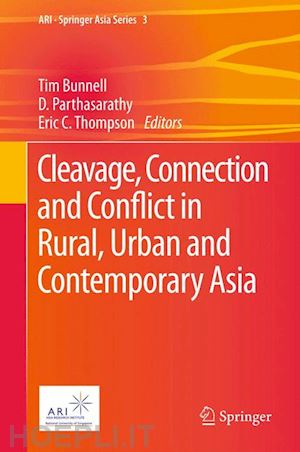
Questo prodotto usufruisce delle SPEDIZIONI GRATIS
selezionando l'opzione Corriere Veloce in fase di ordine.
Pagabile anche con Carta della cultura giovani e del merito, 18App Bonus Cultura e Carta del Docente
Asia, the location of the world’s fastest-growing economies, is also home to some of the fastest rates of urbanization humanity has ever seen, a process whose speed renders long-term outcomes highly unpredictable. This volume contrasts with much published work on the rural/urban divide, which has tended to focus on single case studies. It provides empirical perspectives from four Asian countries: India, Indonesia, Malaysia, and Thailand, and includes a wealth of insights that both critique and expand popular notions of the rural-urban divide. The volume is relevant not just to Asian contexts but to social scientific research on population dynamics more generally.
Rather than deploying a single study to chart national trends, three chapters on each country make possible much more complex perspectives. As a result, this volume does more than extend our understanding of the interplay between cities and hinterlands within Asia. It enhances our notions of rural/urban cleavages, connections and conflicts more generally, with data and analysis ready for application to other contexts. Of interest to diverse scholars across the social sciences and Asian studies, this work includes accounts ranging from rural youth real estate entrepreneurs in Hyderabad, India, to social development in Aceh province in Indonesia, devastated by the 2004 tsunami, to the relationship between urban space and commonly held notions of the supernatural in Thailand’s northern city of Chiang Mai.
CHAPTER 1: Introduction: Place, society and politics across urban and rural Asia:Eric C. Thompson, Tim Bunnell and D. Parthasarathy.- PART I: INDIA: CHAPTER 2: Rural, Urban, Regional: Re-Spatializing Capital and Politics in India: D. Parthasarathy.- CHAPTER 3: Rural youth as real estate entrepreneurs in globalizing Hyderabad: Anant Maringanti.- CHAPTER 4: Livelihoods and Development: Socio-economic Exclusion in Mumbai’s Hinterland: Stephen Louw and Parthsarathi Mondal.- PART II: INDONESIA: CHAPTER 5: Regional governance in decentralizing Indonesia: Learning from the success of inter-local government cooperation in Metropolitan Yogyakarta: Fikri Zul Fahmi, Delik Hudalah and Tommy Firman.- CHAPTER 6: Urban-Rural Connections: Banda Aceh through Conflict, Tsunami and Decentralization: Michelle Ann Miller and Tim Bunnell.- CHAPTER 7: Urbanization without development: The cases of Cirebon and Gresik on Java’s North Coast: Riwanto Tirtosudarmo: PART III: MALAYSIA.- CHAPTER 8: Sense of place and the politics of ‘insider-ness’ in villages undergoing transition: the case of city kampung on Penang island
: Suriati Ghazali.- CHAPTER 9: Gender and the interplay of rural and urban: A Malaysian case: Maila Stivens.- CHAPTER 10: Urban Cosmopolitan Chauvinism and the Politics of Rural Identity: Eric C. Thompson: PART IV: THAILAND: CHAPTER 11: Gendered Nation and Classed Modernity: The Perceptions of Mia Farang (Foreigners’ Wives) in Thai Society: Sirijit Sunanta.- CHAPTER 12: Redrawing Thai Political Space: The Red-shirt Movement: Chairat Charoensin-o-larn.- CHAPTER 13: The City as Promise and Ruin: The supernatural and urban change in Chiang Mai: Andrew Johnson.











Il sito utilizza cookie ed altri strumenti di tracciamento che raccolgono informazioni dal dispositivo dell’utente. Oltre ai cookie tecnici ed analitici aggregati, strettamente necessari per il funzionamento di questo sito web, previo consenso dell’utente possono essere installati cookie di profilazione e marketing e cookie dei social media. Cliccando su “Accetto tutti i cookie” saranno attivate tutte le categorie di cookie. Per accettare solo deterninate categorie di cookie, cliccare invece su “Impostazioni cookie”. Chiudendo il banner o continuando a navigare saranno installati solo cookie tecnici. Per maggiori dettagli, consultare la Cookie Policy.